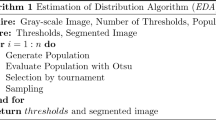Abstract
In this paper, we investigate the Max-Cut problem and propose a probabilistic heuristic to address its classic and weighted version. Our approach is based on the Estimation of Distribution Algorithm (EDA) that creates a population of individuals capable of evolving at each generation towards the global solution. We have applied the Max-Cut problem for image segmentation and defined the edges’ weights as a modified function of the L2 norm between the RGB values of nodes. The main goal of this paper is to introduce a heuristic for Max-Cut and additionally to investigate how it can be applied in the segmentation context.
Access this chapter
Tax calculation will be finalised at checkout
Purchases are for personal use only
Preview
Unable to display preview. Download preview PDF.
Similar content being viewed by others
References
Estimation of Distribution Algorithms: A New Tool for Evolutionary Computation (Genetic Algorithms and Evolutionary Computation). Springer (October 2001)
Bäck, T.: Evolutionary algorithms in theory and practice: evolution strategies, evolutionary programming, genetic algorithms. Oxford University Press, Oxford (1996)
Baluja, S.: Population-based incremental learning: A method for integrating genetic search based function optimization and competitive learning (1994)
Boykov, Y., Lea, G.F.: Graph Cuts and Efficient N-D Image Segmentation. Int. J. Comput. Vision 70(2), 109–131 (2006)
Boykov, Y., Veksler, O., Zabih, R.: Markov random fields with efficient approximations. In: Proceedings of IEEE Conference on Computer Vision and Pattern Recognition, USA, pp. 648–655. IEEE Computer Society (1998); Also as Cornell CS technical report TR97-1658, December 3 (1997)
Boykov, Y.Y., Jolly, M.P.: Interactive graph cuts for optimal boundary & region segmentation of objects in N-D images, vol. 1, pp. 105–112 (2001)
Chowdhury, N., Murhty, C.: Minimal spanning tree based clustering technique: Relationship whith bayes classifier. Pattern Recognition 30(11), 1919–1929 (1997)
Duarte, A., Sánchez, A., Fernández, F., Cabido, R.: A low-level hybridization between memetic algorithm and vns for the max-cut problem. In: Proceedings of the 2005 Conference on Genetic and Evolutionary Computation, GECCO 2005, pp. 999–1006. ACM, New York (2005)
Felzenszwalb, P.F., Huttenlocher, D.P.: Efficient graph-based image segmentation. International Journal of Computer Vision 59(2), 167–181 (2004)
Fiedler, M.: A property of eigenvectors of nonnegative symmetric matrices and its application to graph theory. Checz Mathematical Journal 25(100), 619–633 (1975)
Garey, M.R., Johnson, D.S.: Computers and Intractability: A Guide to the Theory of NP-Completeness. W. H. Freeman & Co., New York (1979)
Geman, S., Geman, D.: Stochastic relaxation, gibbs distribution, and the bayesian restoration of images. IEEE Transactions on Pattern Analysis and Machine Intelligence 6, 721–741 (1984)
Goemans, M.X., Williamson, D.P.: Improved approximation algorithms for maximum cut and satisfiability problems using semidefinite programming. J. ACM 42(6), 1115–1145 (1995)
Hadlock, F.: Finding a Maximum Cut of a Planar Graph in Polynomial Time. SIAM Journal on Computing 4(3), 221–225 (1975)
Håstad, J.: Some optimal inapproximability results. J. ACM 48(4), 798–859 (2001)
Haxhimusa, Y., Kropatsch, W.: Segmentation Graph Hierarchies. In: Fred, A., Caelli, T.M., Duin, R.P.W., Campilho, A.C., de Ridder, D. (eds.) SSPR&SPR 2004. LNCS, vol. 3138, pp. 343–351. Springer, Heidelberg (2004)
Jain, A.K., Dubes, R.: Algorithms for Clustering Data. Prentice Hall, Berlin (1988)
Kaporis, A.C., Kirousis, L.M., Stavropoulos, E.C.: Approximating almost all instances of max-cut within a ratio above the håstad threshold. In: Azar, Y., Erlebach, T. (eds.) ESA 2006. LNCS, vol. 4168, pp. 432–443. Springer, Heidelberg (2006)
Karp, R.M.: Reducibility among combinatorial problems. In: Miller, R.E., Thatcher, J.W. (eds.) Complexity of Computer Computations, pp. 85–103. Plenum Press (1972)
Lance, J., Williams, W.: A general theory of classificatory sorting strategies: I hierarchical systems. Journal on Computing 9, 373–380 (1967)
Luo, B., Wilson, R.C., Hancock, E.R.: Spectral feature vectors for graph clustering. In: Caelli, T.M., Amin, A., Duin, R.P.W., Kamel, M.S., de Ridder, D. (eds.) SSPR & SPR 2002. LNCS, vol. 2396, pp. 83–93. Springer, Heidelberg (2002)
Martin, D., Fowlkes, C., Tal, D., Malik, J.: A database of human segmented natural images and its application to evaluating segmentation algorithms and measuring ecological statistics. In: Proc. 8th Int’l Conf. Computer Vision, vol. 2, pp. 416–423 (July 2001)
Noma, A., Graciano, A.B., Cesar Jr., R.M., Consularo, L.A., Bloch, I.: Interactive image segmentation by matching attributed relational graphs. Pattern Recognition 45(3), 1159–1179 (2012)
Pavan, M., Pelillo, M.: Graph-theoretic approach to clustring and segmentation. In: Proceedings of IEEE Conference on Computer Vision and Pattern Recognition, vol. 1, pp. 145–152. IEEE Computer Society (2003)
Rother, C., Kolmogorov, V., Blake, A.: “grabcut”: interactive foreground extraction using iterated graph cuts. ACM Trans. Graph. 23(3), 309–314 (2004)
Shi, J., Malik, J.: Normalized Cuts and Image Segmentation. IEEE Transactions on Pattern Analysis and Machine Intelligence 22(8), 888–905 (2000)
Urquhart, R.: Graph theoretical clustering based on limited neighborhood sets. Pattern Recognition 15(3), 173–187 (1982)
Wu, Z., Leahy, R.M.: An optimal graph theoretic approach to data clustering: Theory and its application to image segmentation. IEEE Transactions on Pattern Analysis and Machine Intelligence 15(11), 1101–1113 (1993)
Zahn, C.: Graph-theoretical methods for detecting and describing gestal clusters. IEEE Transaction on Computing 20, 68–86 (1971)
Author information
Authors and Affiliations
Editor information
Editors and Affiliations
Rights and permissions
Copyright information
© 2013 Springer-Verlag Berlin Heidelberg
About this paper
Cite this paper
de Sousa, S., Haxhimusa, Y., Kropatsch, W.G. (2013). Estimation of Distribution Algorithm for the Max-Cut Problem. In: Kropatsch, W.G., Artner, N.M., Haxhimusa, Y., Jiang, X. (eds) Graph-Based Representations in Pattern Recognition. GbRPR 2013. Lecture Notes in Computer Science, vol 7877. Springer, Berlin, Heidelberg. https://doi.org/10.1007/978-3-642-38221-5_26
Download citation
DOI: https://doi.org/10.1007/978-3-642-38221-5_26
Publisher Name: Springer, Berlin, Heidelberg
Print ISBN: 978-3-642-38220-8
Online ISBN: 978-3-642-38221-5
eBook Packages: Computer ScienceComputer Science (R0)




